Care and Maintenance of an Electric Guitar
Care and maintenance techniques to keep in mind
Try adjusting the height of the pickup
Surprisingly few guitarists have tried adjusting the height of the pickups in their electric guitars. Electric guitar pickups can be easily moved with just a single screwdriver. This section gives a brief introduction of how to adjust the pickups.
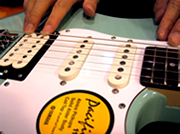
In most electric guitars, pickup height is adjusted using screws on either side of the pickups. The height of a pickup has an effect on sound volume-the higher the pickup, the louder the sound. Of course, this does not mean you should just raise it as much as possible. The height of the pickup also changes the quality of the sound. Some say that a lower pickup produces a nicer sound, but this is a matter of personal opinion.
One thing to keep in mind is that raising the pickup too much can cause it to touch the strings. Be especially careful as pressing the strings higher up on the neck causes the strings to sink much more than pressing the strings lower on the neck. Also keep in mind the fact that the pickup itself is a strong magnet. If the strings are too close to the pickup its magnetic force could inhibit string vibration, worsening sustain and causing pitch instability.
After adjusting the pickup, there should be a gap of around 1.5 mm between the pickup and string on the side of string 1 when you press the last fret. On the side of string 6, the sound will get louder so you should adjust the gap to 2 mm to 2.5 mm. Uses these numbers as a guide and try to find the height that works best for you.
Simply adjusting the pickup should not damage your guitar or render it incapable of producing sound, so it is a great project for beginners or even those who are not mechanically inclined. Give it a try and see how the timbre and volume changes as you adjust. You just might gain an appreciation of how fun and interesting it can be to adjust your own instrument!
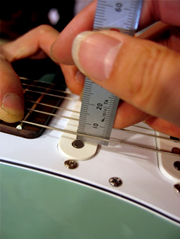
2 to 2.5 mm on the side of string 6.
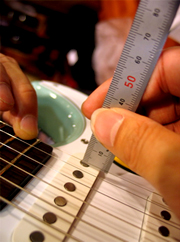
Around 1.5 mm on the side of string 1.
Use rubbing alcohol and a cotton swab to prevent crackling noises
Jack connection defects-i.e. crackling-almost always occur with electric guitars or bass guitars that have not been used for a while. When an old electric guitar is plugged into an amplifier, it may produce an unpleasant static. This is what is meant by "crackling."
In most cases this is a connectivity issue caused by dust inside the jack. This problem is easy to solve however-just clean the jack. To do this you will need a cotton swab and either disinfectant absolute alcohol, or ethanol. You can purchase either at any drugstore, though you probably already have one or the other at home.
Cleaning is easy. As shown in the photo, apply ethanol to the cotton swab, then clean the inside of the jack. Be sure to use rubbing alcohol, as substances that include oils such as lubricant sprays can actually cause more dust to adhere to the jack. Note that some contact cleaners may include oils, so be sure to check the ingredients carefully prior to use.
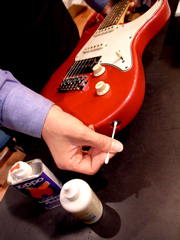
Cleaning inside the jack with an ethanol-dipped cotton swab
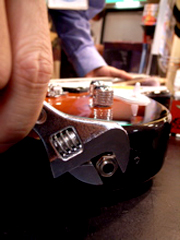
Take care of any loose jacks
The jack itself may come loose and rattle around inside the guitar. If this is not remedied of you could accidentally pull the jack from its wiring. You should check the jack each time you play to see if it has gotten loose. It is be good idea to keep a small monkey wrench in your toolbox.
How to store amplifiers and effectors
It can be a little more complicated to store electric guitars. In addition to the instrument itself, there are many accessories that need to be stored, such as cables, effectors, and of course guitar amplifiers. This section describes how best to handle and maintain these accessories.
There is one thing you can do that just takes a bit of care but will pay off in spades. That is, pack up your accessories-or in other words, putting them in bags. This alone will keep your equipment in good condition for a longer time. Placing your equipment in bags will protect them from dust. This is important as dust tends to collect in input/output terminals and other connections as well as effector knobs. Protecting your equipment from dust will keep everything running and moving smoothly.
Although some guitarists may just leave effectors in their guitar cases, if the effector touches the guitar in the case it could damage it. If you absolutely must transport the effector in the case, it is a good idea to make a habit of first wrapping the effector in a bag before placing it in your case. When storing everything, you should of course take the effector out of the case.
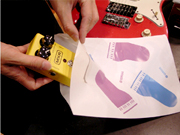
Put everything in bags of the proper size
Guitar amplifiers and other large equipment should not be stored as-is in a closet or the like as this may cause the plug contacts and circuitry to deteriorate due to the humidity. In this case, wrapping equipment in plastic bags can be surprisingly effective in protecting it from damage. This also helps to protect equipment from dust and damage. Give it a try next time you put your equipment away!
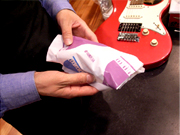
Store like this
Musical Instrument Guide:Electric Guitar Contents
Structure
How to Play
How the Instrument is Made
Choosing an Instrument
Care and Maintenance
Trivia
- Slide guitar playing may have been invented in a bar
- Feedback:Great for guitar playing! Not so great for karaoke...
- What is the difference between an electric guitar and electric acoustic guitar?
- Is there a way to eliminate the noise heard when plugged into an amplifier?
- Whole note down tuning for deeper bass
